Deliciously easy pavlova, made from scratch. This classic Australian dessert features a deliciously crisp white shell and a soft, marshmallow-like centre. Topped with soft whipped cream and piled high with fresh mango and passion fruit, it is the perfect dessert for Christmas celebrations and summer BBQs!

This is a long post full of helpful tips to achieve the perfect pavlova, every time. Some people find pavlova intimidating or need help troubleshooting some common issues. To skip these tips and head straight to the recipe, hit the ‘jump to recipe’ button at the top of the post.
Why you’ll love this recipe
- Easy to make – a fool-proof recipe with easy-to-follow tips, step-by-step photos and troubleshooting tips to help you achieve the perfect pavlova, every time.
- Perfect for any occasion – a staple Aussie dessert at Christmas, family celebrations, picnics, BBQs and more. It makes a lovely warm-weather dessert, piled high with your favourite summer fruits. But you can also serve it in winter, topped with stewed fruits or grated chocolate.
- Make ahead – the advantage of this dessert is that the meringue base can be made in advance. Bake it the day before and decorate it when you are ready to serve!
- Perfect textures – a crisp, delicate exterior that will melt in your mouth and a soft, marshmallow-y centre. It is crunchy and chewy, soft and fluffy all at once!
- Gluten-free – containing egg whites, sugar and gluten-free cornflour, it is naturally gluten free, easy to make and utterly delicious!
Some more Australian dessert ideas, perfect for your next celebration; chocolate ripple cake, hedgehog slice, Maltesers slice and vanilla custard slice.
Ingredients you will need
** This post contains tips and instructions to achieve the best possible results. The photo above is a great guide for when you are in the supermarket, but for full ingredient quantities and methods, please scroll down to the detailed recipe card below!

- Egg whites – beaten into stiff peaks, egg whites form the base of the pavlova. 4 large, fresh eggs are used in this recipe. Weigh the egg whites for accuracy and allow the egg whites to warm to room temperature before beating, to allow more air to enter the mixture.
- Caster sugar – in addition to sweetening the pavlova, caster sugar also helps to stabilise the beaten egg whites and provide the crisp exterior. I recommend caster sugar (superfine sugar) rather than granulated sugar. It dissolves into the egg whites more easily, which will create a smooth texture. Raw or white caster sugar can be used.
- Cornflour – also called corn starch, cornflour helps the meringue to stay soft and marshmallow-y in the centre.
- White vinegar – when added to the beaten egg whites, vinegar (acid) helps them hold onto the air and become fluffy. Use regular white vinegar, or alternatively substitute for equal quantities of cream of tartar or lemon juice. You will not taste the vinegar in the finished pavlova.
- Cream – use heavy, thickened cream suitable for whipping.
- Summer fruits – I use slices of fresh mango and fresh passion fruit pulp, but you can add any of your favourite seasonal fruits like cherries, strawberries, slices of fresh banana, kiwi fruit or berries (or even stewed or poached fruits in winter). Or, swap the fruits for crushed Peppermint Crisp bars, grated chocolate or Nutella.
Step by step instructions
Step 1 – Beat the egg whites to soft peaks;
Place the egg whites into a mixing bowl and using a stand-mixer or handheld beaters on low-medium speed, whip them until they become white and foamy and reach soft peak stage (not stiff peaks). This should take around 5 minutes.

Step 2 – Slowly add the sugar;
While beating on low-medium speed, slowly add the caster sugar (one tablespoon at a time). Adding the sugar slowly allows the sugar to dissolve into the mixture, without making it grainy.
Step 3 – Beat to stiff peaks;
Increase the speed to medium-high and beat the meringue for a further 3 minutes, or until the mixture is thick and glossy and forms stiff peaks.
Test the mixture by rubbing a little between your thumb and finger. It should be smooth, with no graininess from the sugar. If it is still gritty, beat for a little longer, until smooth.
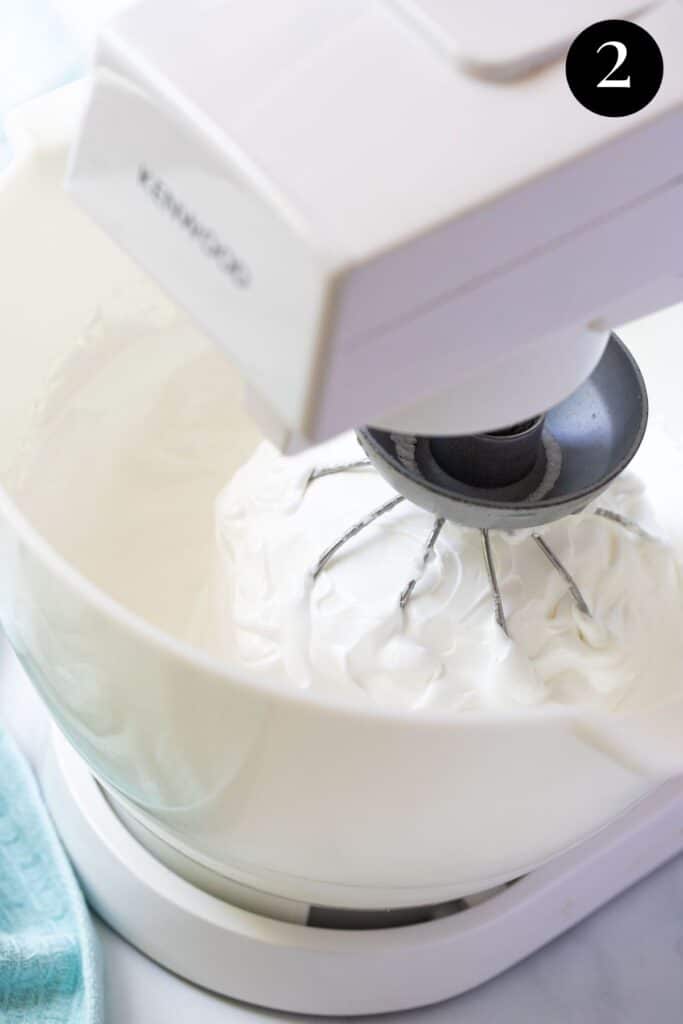
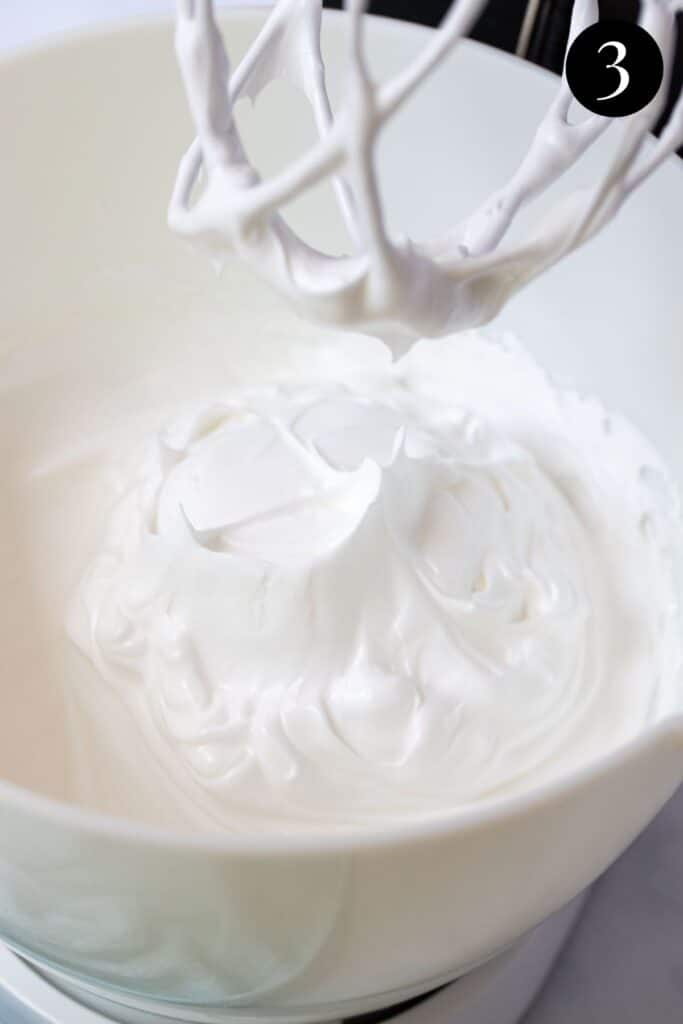
Step 4 – Add the vinegar and cornflour;
Decrease the speed of the beaters to low and add the vinegar and cornflour. Beat only until these ingredients are incorporated into the mixture.
Step 5 – Shape the pavlova;
Line a flat baking tray with baking paper, with a little oil spray underneath the paper to stop it from sliding on the tray.
Use a 20cm-round plate or cake tin to trace a circle on the paper. Working quickly (aim to have the pavlova in the oven in around 5 minutes from when you stop beating), use a spatula to add the meringue to the centre of the circle.
Use the circle as a guide to gently coax the meringue to size. Smooth (or sweep) the sides and level the top of the pavlova.


Step 6 – Bake;
Gently (no bumping or slamming doors!), place the pavlova into the pre-heated 150C oven and immediately turn the heat down to 100C. Bake for 1 and ½ hours, without opening the oven door.
Step 7 – Cool;
Turn the oven off. Leaving the door of the oven closed, leave the pavlova in the oven to cool overnight, or for at least 6 hours.


Step 8 – Decorate;
When you are ready to serve, whip the cream into soft peaks. Add the icing sugar and vanilla and beat until incorporated.
Once cooled, top with the whipped cream, mango and passion fruit (or your choice of summer fruits).
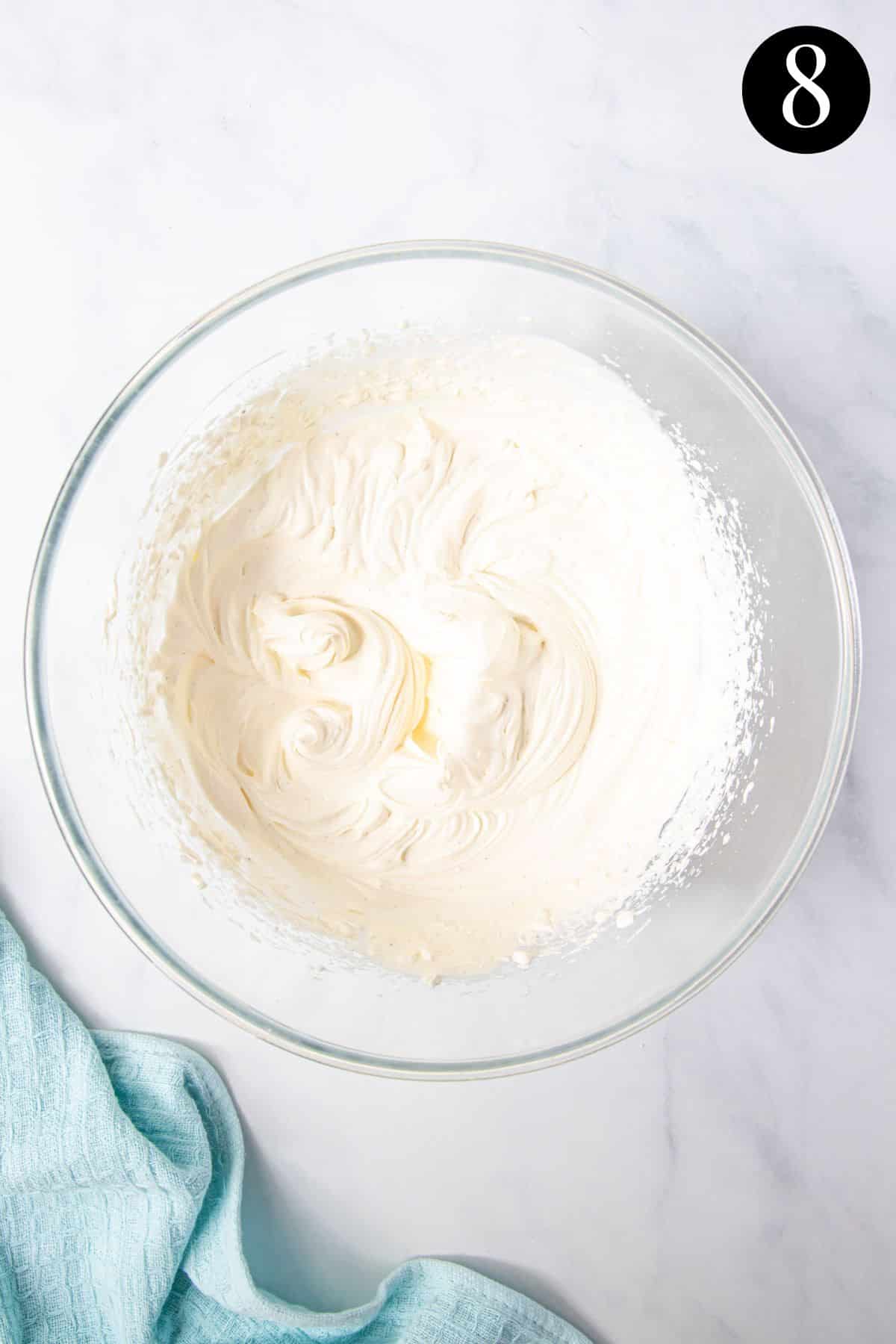
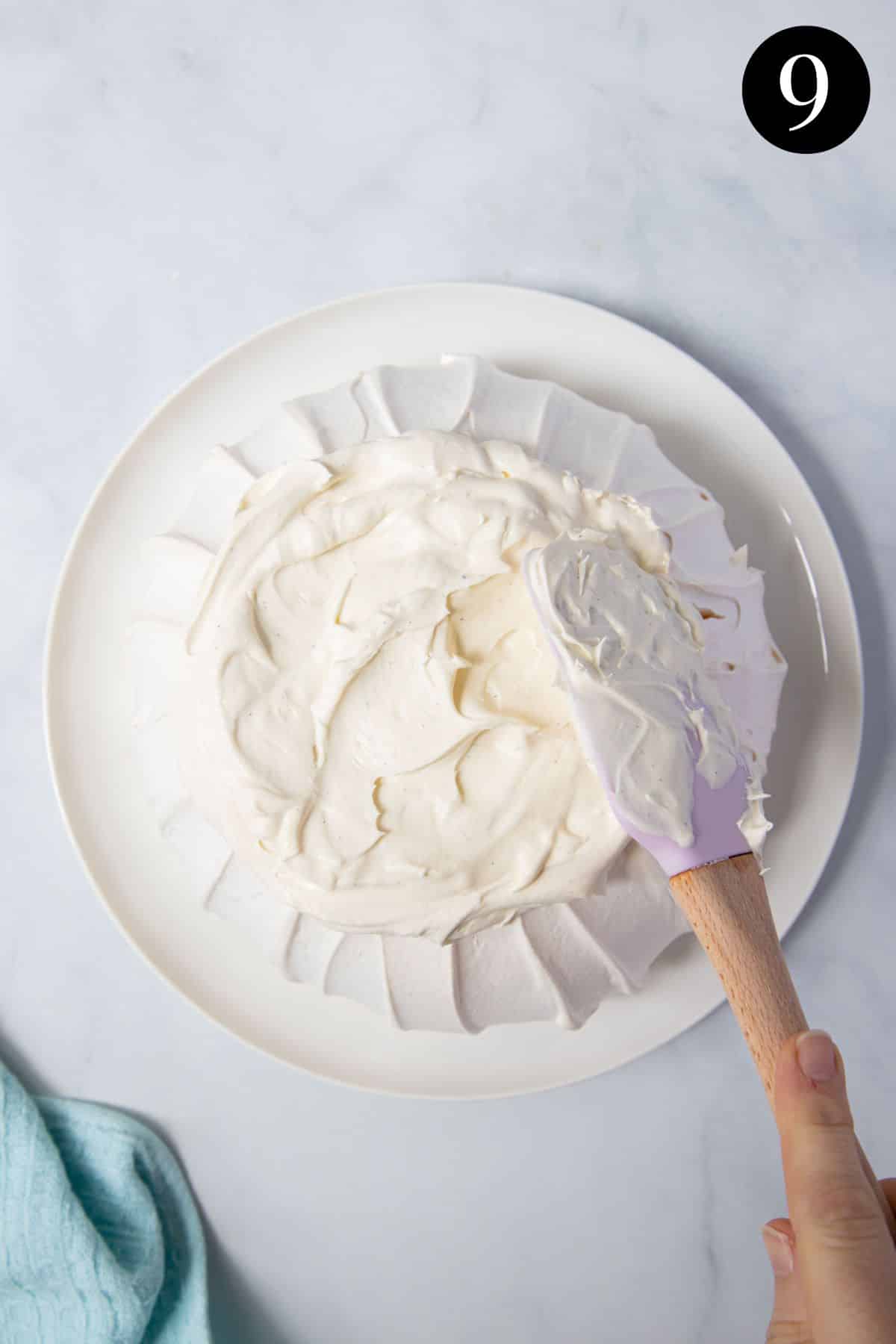
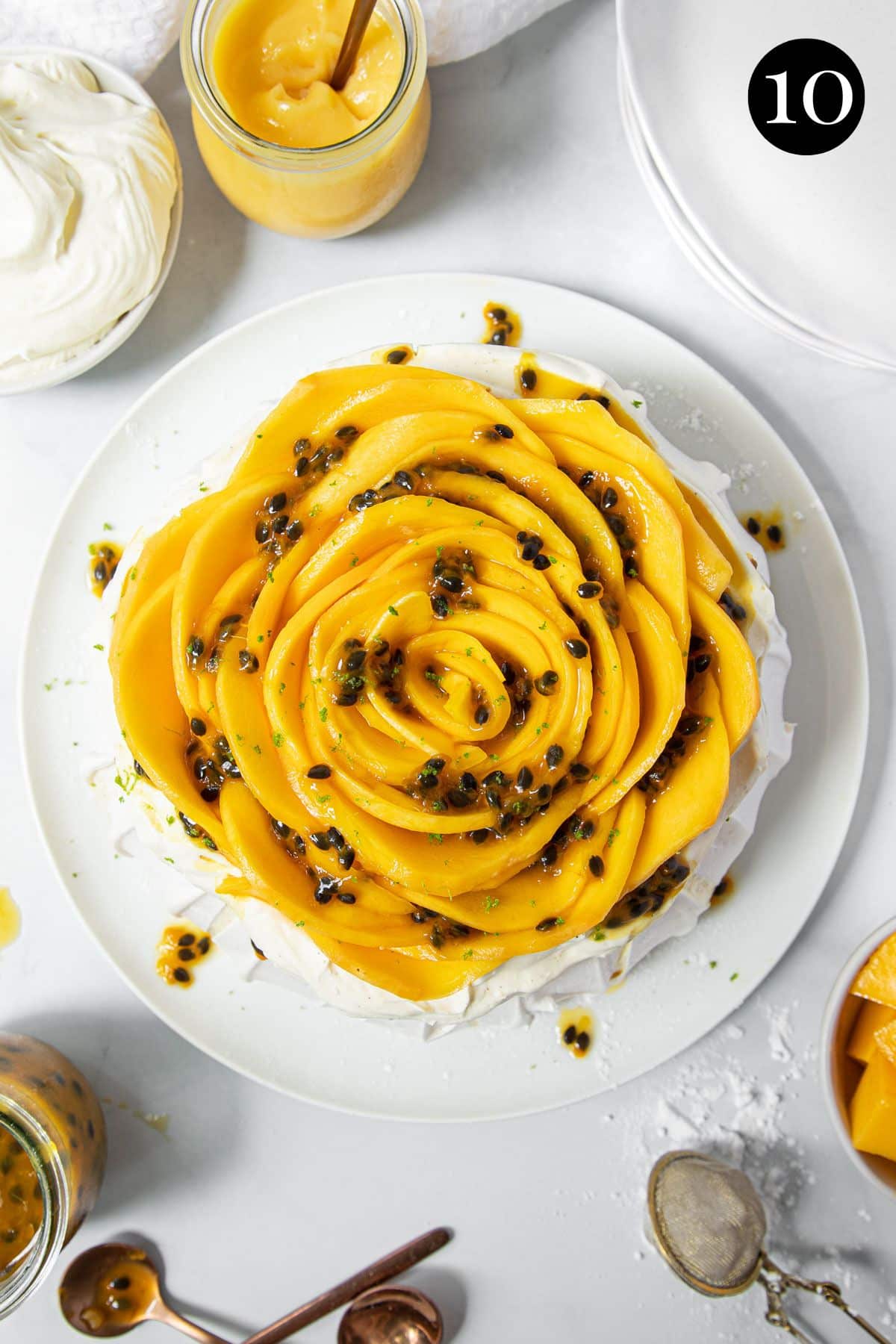
Expert tips
- Use room temperature eggs – cold eggs are harder to whip air into and can cause the mixture to be runny.
- Use clean equipment. Any trace of egg yolk or fats/oils in your bowl will prevent the egg whites from reaching stiff peak stage. Use clean, dry equipment.
- No yolks. Ensure there’s not even a trace of egg yolk in the egg whites when you separate the eggs. Yolks contain fat, which interfere with how the proteins arrange themselves and this can stop the mixture from fluffing up.
- Don’t add the sugar too quickly. Take your time and add 1 tablespoon at a time while beating, until the sugar has fully dissolved. Adding it too quickly can make the meringue grainy and runny, which can cause it to weep.
- Don’t overbeat the egg whites. The pavlova base is made by whisking egg whites into a soft foam (soft peaks) and then slowly adding sugar to incorporate into the foam. During this process, the egg white proteins uncurl and stretch out. This allows air to be trapped in the foam. But if the egg whites are overbeaten, the egg proteins break down and the structure will not hold as much air. This can cause the pavlova to deflate, crack or collapse.
- Don’t beat too fast! Beating the egg whites on a low-medium speed means the air is added slowly, giving you a more stable foam structure and meringue base. It can be tempting to beat them at high speed to speed up the process, but slow and steady is best.
- Baking the pavlova on a low rack in the oven can help to prevent it from cracking.
- Measure the ingredients. Pavlovas are delicate desserts that can be temperamental if variations are made to the recipe. To achieve the perfect texture, weigh and measure the ingredients and adhere to the exact recipe.
- Avoid knocking the air from the meringue mixture! Pavlova depends on the air that has been beaten into the egg whites. The air is what creates the light, airy base. This means no tapping or knocking the bowl, no banging the beaters on the bowl to remove mixture, no slamming oven doors and no stomping around near the oven while the pavlova is baking!
- Pre-heating the oven and then reducing the temperature immediately will help to get the crisp exterior started and stabilise the meringue.
- Don’t open the oven door! It is tempting to sneak a peek and see how the pavlova is going, but a sudden change in temperature can cause it to collapse or crack. Once cooked, leave it in the oven overnight, or for at least 6 hours with the door completely closed to cool completely before moving.
- Topping ideas; I opt for fresh summer fruits like mango and passion fruit, but you can add any seasonal or stewed fruits that you love! Pavlova is the perfect base for any of your favourite dessert toppings! It is fabulous with whipped cream and crushed Peppermint Crisp or Cadbury Flake. Nutella, caramel sauce or lemon curd also make lovely additions. Banana and salted caramel sauce are also perfect for a banoffee version!
- Be careful moving the pavlova onto your serving dish. It will be quite fragile and care should be taken to remove the paper.
- Collapsed pav? If your pavlova collapses, don’t worry! It really is such a forgiving recipe. If the meringue shell cracks or collapses in the middle, it is easy to piece it back together. Just cover it with cream and toppings and no one will even know.
FAQs
‘Weeping’ occurs when droplets of liquid seep from the pavlova and pool at the bottom. This liquid can make the pavlova collapse and become soggy. There are three reasons this can happen;
1. The sugar in the meringue is not fully dissolved and ‘weeps’ out of the pavlova. It is important to add the sugar 1 tablespoon at a time, to ensure it dissolves and incorporates completely into the mixture. Any grains of undissolved sugar will readily absorb water and cause weeping.
2. The pavlova has been made in a humid environment. Sugar in the pavlova will draw water in from the surrounding air. In especially humid conditions, the excess moisture in the air can be absorbed by the sugar, causing the egg whites to weep and collapse. If you are baking pavlova on a humid day, try to keep the environment as cool and dry as possible. An air conditioner can help with this (if you don’t have one, try to bake at night or the coolest time of day), as well as keeping the pavlova sealed in the oven to cool overnight. Also keep other steaming hot dishes out of the kitchen while you prepare the pavlova.
3. Overbeating the egg whites. If the egg whites are overbeaten to a grainy texture, the protein in the egg can lose its structure and they won’t hold as much air. To avoid this, beat the egg whites at low-medium speed until soft peaks form. Once the sugar is added, only beat until glossy, thick and stiff and then quickly add the vinegar and cornflour on low speed, only until incorporated.
If your pavlova cracks or collapses, it is usually because the marshmallow-like centre has shrunk away from the meringue shell, causing it to cave in. This can be caused by;
1. Overbeating the egg whites, meaning they cannot hold as much air. Only beat the egg whites until thick and glossy. Overbeating will make them lumpy or grainy.
2. A sudden change in temperature. Pavlova needs to be baked slowly, at a low temperature. This helps the meringue crisp and dry out on the outside and keep it stable in the middle. A rapid change in temperature can cause the centre of the pavlova to shrink away, causing it to crack or collapse. This can happen by opening the oven door or removing the pavlova from the oven before it has had time to cool. Once the pavlova has cooked, keep the oven door closed and leave it sit in the oven overnight, to slowly cool.
Once baked, allow the pavlova to cool in the oven overnight with the door closed. Then, store it (without cream or fruit) in an airtight container at room temperature until you are ready to decorate. While it is best eaten in the first day after being baked, it will store this way for 1-2 days. Storing pavlova in the fridge will soften the crispy shell, so only add the whipped cream and toppings when you are ready to serve. Leftover (decorated) pavlova will need to be kept in the fridge due to the cream, but it will soften once stored this way.

Related recipes
Tried this recipe? Please leave a star ⭐⭐⭐⭐⭐ rating or leave a review below and let me know how you went!
Hungry for more? Subscribe to my newsletter and follow along on Facebook, Instagram and Pinterest for the latest recipes and news.
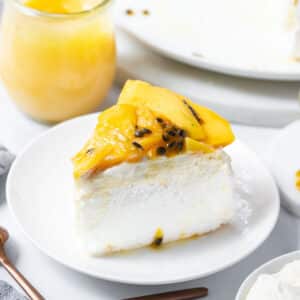
Easy Pavlova with Mango & Passion Fruit
Ingredients
- 150 ml egg whites approximately 4 large eggs whites, at room temperature
- 1 cup caster sugar 215 grams, superfine sugar
- 1 tablespoon cornflour
- 1 teaspoon white vinegar or cream of tartar or lemon juice
To decorate
- 450 ml cream heavy, thickened cream, suitable for whipping
- 1 teaspoon vanilla bean paste
- 2-3 tablespoons icing sugar
- 2 mangoes fresh, sliced
- passion fruit pulp extra
- 1 lime zest optional
Instructions
For the pavolva
- Separate the eggs and measure 150ml/150grams of egg whites. Set them aside and allow to come to room temperature.
- Pre-heat the oven to 150 °C (302 F) and line a baking tray with baking paper. Place a small amount of oil spray underneath the paper to stop it from sliding.
- Using a 20cm plate or cake tin, trace a 20 cm/8 inch circle onto the middle of the baking paper.
- Using a clean, dry bowl and electric stand mixer, beat the egg whites at low-medium speed for around five minutes, until the whites are white, foamy and forming soft peaks.
- While beating, slowly add the caster sugar, one tablespoon at a time.
- Once all of the sugar has been added, increase the speed to medium-high (not top speed) and continue beating for around 3 minutes, until the egg whites are thick, glossy and form stiff peaks. *By this stage, the sugar should have dissolved. You can test this by pinching a little of the egg whites between your fingers. The mixture should not feel gritty. If it does, beat for a further minute until the mixture is smooth.
- Decrease the speed to low and add the cornflour and vinegar. Mix only until combined and then turn off the mixer. Don't overbeat.
- Working quickly, use a spatula to gently add the meringue to the centre of the circle on the lined baking tray. Use the circle as a guide to gently coax the meringue to size. Smooth (or sweep) the sides and level the top of the pavlova.
- Place the pavlova in the oven and immediately turn the temperature down to 100°C (212 F). Bake for 1 hour and 30 minutes (without opening the oven door), until the shell of the pavlova is crisp. Turn the oven off and leave the oven door closed. Leave the pavlova to cool completely in the oven, overnight or for at least six hours.
For the whipped cream
- When you are ready to decorate the pavlova, whip the cream together with the vanilla and icing sugar until it stands in soft peaks. Be careful not to over-beat.
To decorate
- Top the pavlova with dollops whipped cream, spoons of passion fruit and slices of fresh mango. Sprinkle with a little lime zest or fresh mint, if desired.
Notes
- Use room temperature eggs – cold eggs are harder to whip air into and can cause the mixture to be runny.
- Use clean equipment. Any trace of egg yolk or fats/oils in your bowl will prevent the egg whites from reaching stiff peak stage. Use clean, dry equipment.
- No yolks. Ensure there’s not even a trace of egg yolk in the egg whites when you separate the eggs. Yolks contain fat which interfere with how the proteins arrange themselves and this can stop the mixture from fluffing up.
- Don’t add the sugar too quickly. Take your time and add 1 tablespoon at a time while beating, until the sugar has fully dissolved. Adding it too quickly can make the meringue grainy and runny, which can cause it to weep.
- Don’t overbeat the egg whites. The pavlova base is made by whisking egg whites into a soft foam (soft peaks) and then slowly adding sugar to incorporate into the foam. During this process, the egg white proteins uncurl and stretch out. This allows air to be trapped in the foam. But if the egg whites are overbeaten, the egg proteins break down and the structure will not hold as much air. This can cause the pavlova to deflate, crack or collapse.
- Don’t beat too fast! Beating the egg whites on a low-medium speed means the air is added slowly, giving you a more stable foam structure and meringue base. It can be tempting to beat them at high speed to speed up the process, but slow and steady is best.
- Baking the pavlova on a low rack in the oven can help to prevent it from cracking.
- Measure the ingredients. Pavlovas are delicate desserts that can be temperamental if variations are made to the recipe. To achieve the perfect texture, weigh and measure the ingredients and adhere to the exact recipe.
- Avoid knocking the air from the meringue mixture! Pavlova depends on the air that has been beaten into the egg whites. The air is what creates the light, airy base. This means no tapping or knocking the bowl, no banging the beaters on the bowl to remove mixture, no slamming oven doors and even no stomping around near the oven while the pavlova is baking!
- Pre-heating the oven and then reducing the temperature immediately will help to get the crisp exterior started and stabilise the meringue.
- Don’t open the oven door! It is tempting to sneak a peek and see how the pavlova is going, but a sudden change in temperature can cause it to collapse or crack. Once cooked, leave it in the oven overnight, or for at least 6 hours with the door completely closed to cool completely before moving.
- Topping ideas; I opt for fresh summer fruits like mango and passion fruit, but you can add any seasonal or stewed fruits that you love! But pavlova can also be used as a base for any of your favourite dessert toppings! It is fabulous with whipped cream and crushed Peppermint Crisp or Cadbury Flake. Nutella, caramel sauce or lemon curd also make lovely additions. Banana and salted caramel sauce are also perfect for a banoffee version!
- Collapsed pav? If your pavlova collapses, don’t worry! It really is such a forgiving recipe. If the meringue shell cracks or collapses in the middle, it is easy to piece it back together. Just cover it with cream and toppings and no one will even know.
- Storage; once baked, allow the pavlova to cool in the oven overnight. Then, store it (without cream or fruit) in an airtight container at room temperature. While it is best eaten the following day after being baked, it will keep this way for 1-2 days. Storing pavlova in the fridge will soften the crispy shell, so only add the whipped cream and toppings when you are ready to serve. Leftover decorated pavlova will need to be kept in the fridge due to the cream, but it will soften.
- Please note that the nutrition information is based on the pavlova (decorated with cream and fruit) being divided into 8 slices, with one slice being one serve. The nutritional information is an estimate only and does not take into account any additional toppings or sides served with the pavlova.
- This recipe is made using Australian cups and spoon measurements. Any reference to cups or spoons in this recipe is in Australian metric. Due to cup sizes varying from country to country, I advise adjusting if necessary.
Nutrition
Are you following us on Facebook, Instagram and Pinterest?
Update Notes: This recipe was originally published in January 2019, but was re-published with new information, helpful tips and photos in November 2022.
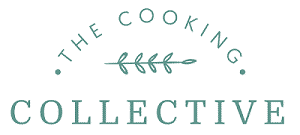

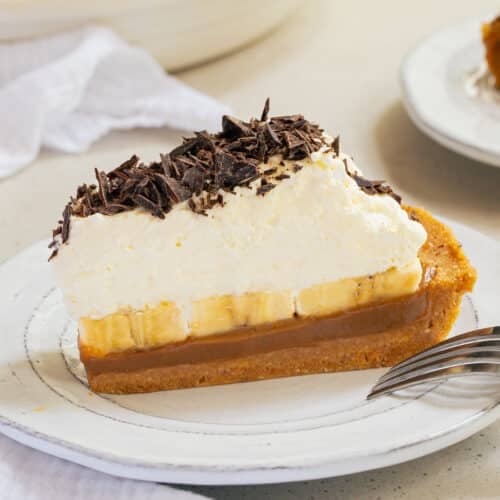
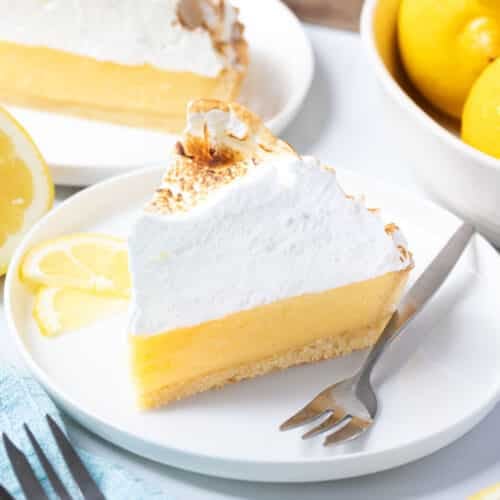
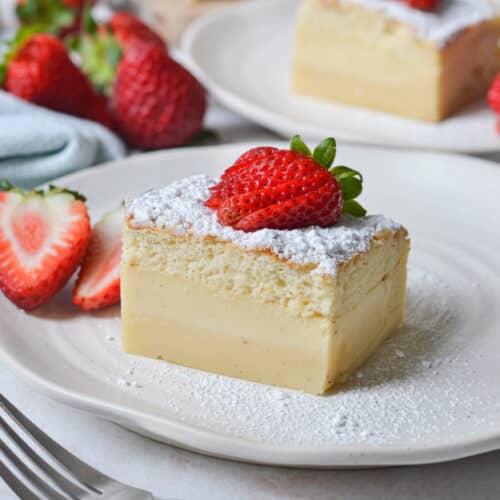
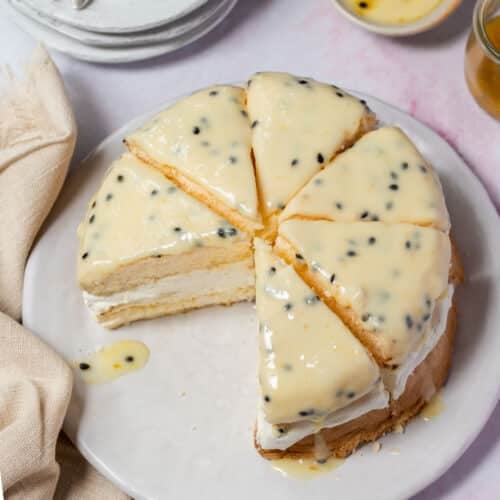
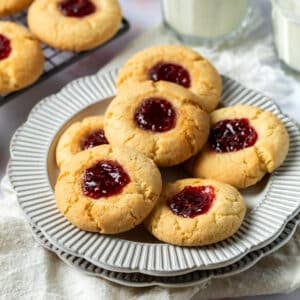

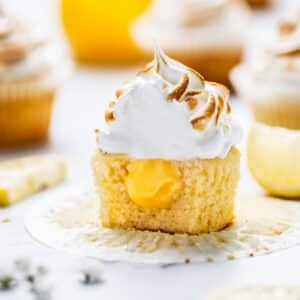
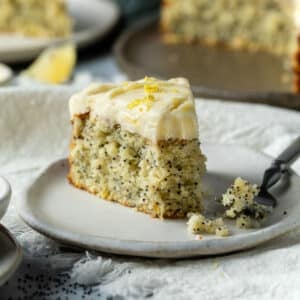
Jelena Župančić says
Hi there, can you replace fresh fruit with passion fruit spread, made of 70% fruit, with added sugar?
Thank you
Andrea Geddes says
Hello Jelena! Once the pavlova is made, you can decorate it however you like! I love to add some passion fruit curd with whipped cream and fresh fruit. But I’m sure your passion fruit spread would be a lovely addition too. Enjoy! Andrea.
Ga says
Hello!
Thanks for this delicious recipe which looks yummy 🙂
Can I make the curd replacing passion fruit with canned peaches (thinking of making a puree with some)?
Does the temperature work for a gas oven too?
Thank you!
Andrea Geddes says
Hi! You can definitely try to add (drained) peaches to the curd, however I’m unsure how thick it will turn out this way. I’d avoid adding any excess liquid from the peaches. While the temperature will be the same for a gas oven, all ovens are slightly different so you will need to keep an eye on it the first time making it. I hope you love it! Andrea.
Sharyn says
Hi there, are these oven temperatures for fan forced?
Thanks!
Andrea Geddes says
Hi Sharyn! All of my recipes are tested in a fan-forced oven. These temperatures are for fan forced- so you may need to adjust if you don’t have a fan. Thanks for asking! Have a great day. Andrea.
Robyn says
This looks stunning – a perfect show stopping Christmas dessert.
TheCookingCollective says
Thank you Robyn! It would certainly make for a lot of very happy people at Christmas dinner!
Sally says
I LOVE pav so much, and mango and passionfruit are my absolute favourite toppings. This is so perfect for summer and I love your detailed guide to making the pav as it can be a bit tricky.
TheCookingCollective says
Hi Sally! I’m so glad you found the tips helpful. It really is such a lovely summery dessert and the mango and passion fruit are the perfect tropical topping!
Sylvie says
What a great Australian dessert! So perfect for summer with those tropical flavours, and it looks gorgeous too – it will definitely make everyone happy at the Christmas table!
TheCookingCollective says
Thank you Sylvie! It is such a classic Aussie dessert- and I love the addition of the tart tropical flavours to balance the sweet.